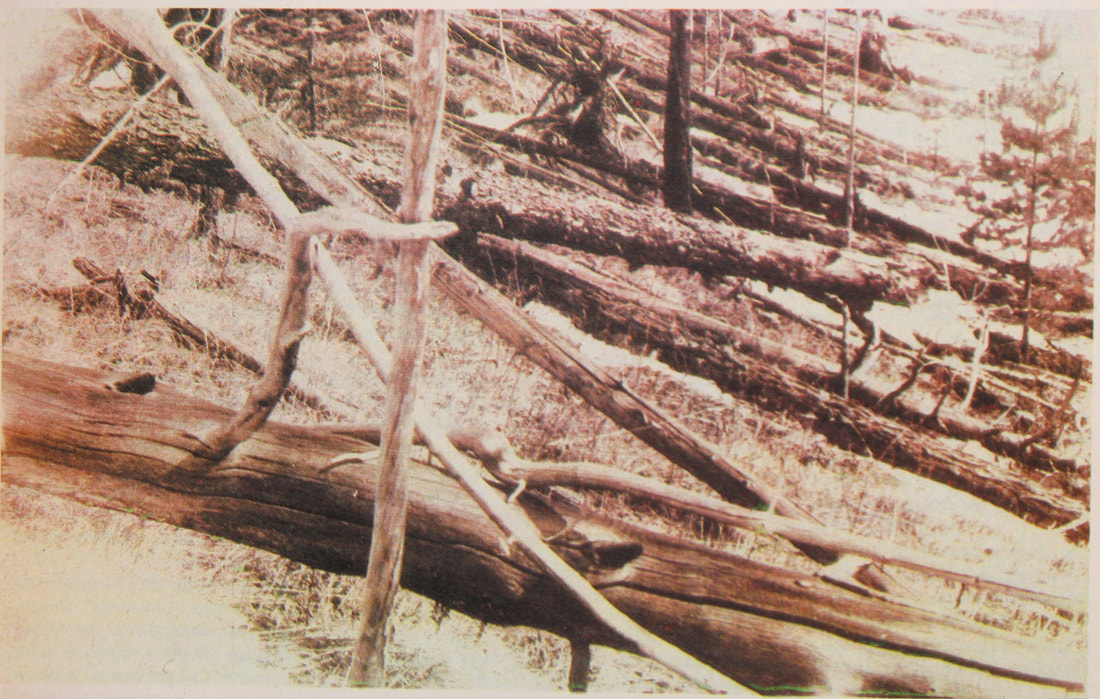Trees at the apparent centre of the flattening were not felled, but their branches had all been stripped and heavily scorched. Outside the immediate centre of the blast, trees were flattened radially from the epicentre. Houses in the small town of Vanovara (now called Vanavara, 900km north of Irkutsk), 70km from the centre of the blast were substantially damaged. There are no confirmed fatalities from the event, most likely because there would have been very few humans living or working in the immediate vicinity.
Dans la zone de l’épicentre les arbres n’étaient pas tombés mais mais leurs branches avaient été brûléss. Un peu plus loin du centre de l’impact les arbres avaient été abattus. Les maisons dans la petite ville de Vanovara (maintenant Vanavara, à 900km nord d’Irkutsk), et à 70km du centre de l’impact ont été endommagées. Il n’y a pas eu de victimes humaines parce que la région est si peu peuplée
The upright trees are new growth since 1908
Image Credit: Leonid Kulik; May 1929. Source : wikimedia
https://commons.wikimedia.org/wiki/File:Tunguska_event_fallen_trees.jpg#cite_note-1
Due to the remoteness of the area, the first scientific investigation into the incident, led by the mineralogist and meteorite researcher Leonid Kulik (b.1883 d.1942) was not held until 1927, following his initial survey of 1921. Many expeditions to the region have occurred over the past few decades however with the area now having been visited by researchers from across the globe.
Many ludicrous alternatives have been proposed and, in our view, these should all be taken in the same ilk as conspiracy theories. One of the less eccentric ideas was that the devastation was caused by ignition of a build-up on atmospheric methane emanating from the bogs and swamps. Apart from not explaining witness accounts this has been discounted for bog chemistry reasons.
No impact crater has ever been detected. A hypothesis that the small lake Suslov and/or the Bublik bog are the impact crater(s) caused by an object hitting the ground has been rejected due to the age of sediments at their depths. Mineralogical extracts from the soil/peat and the trees of the area indicate elevated levels of nickel and iron within unusual silicate and magnetite spheres. These strongly point to a heated, extra-terrestrial source.
Current considerations of this event are that it was caused by a series of airburst explosions, at heights of between 5 to 10km above the ground, due to the disintegration of a comet or rubble-pile asteroid.
Convincing, although with residual problematic aspects, hypotheses have been published for both the asteroid and the comet impact ideas, and the nature of the progenitor continues to be investigated and debated.
Estimates for the size of the progenitor object vary from ~60 to ~200m in dimension, depending upon the object’s density. If the object was an asteroid, considering the high iron/nickel residues, it is likely to be towards the lower of this size range.
This compares to the small asteroid which exploded and hit the ground above the city of Chelyabinsk on the 13th February 2013. The Chelyabinsk progenitor was an Apollo class asteroid of a very modest 17m in size. The energy released in the Tunguska event has been assessed as being ~50 times greater than that released in Chelyabinsk. Had the Tunguska event occurred within an urban / metropolitan area today, the city/towns within the area would have been destroyed and there would have been a very large number of deaths.
Statistically, it has been estimated that a Chelyabinsk-like incident will occur about once every 20 to 50 years, with a Tunguska-like incident every 200 to 300 years. We look at asteroids in detail in our book, and will discuss their nature and threats in a future blog series.
For now though, please be reassured that there is no known asteroid or comet which will collide with the Earth within the next 100 years. We will however look at some that will come a little disconcertingly close, and of course it is always the things we don’t know about that are the most dangerous….
[1] Testimony of eyewitnesses of the Tungus Fall
N. Vasiliev et al 1981.
http://tunguska.tsc.ru/ru/science/1/0
[2] Perplexities of the Tunguksa meteorite.
C. Trayner The Observatory 114, 227, 1994.
http://adsabs.harvard.edu/abs/1994Obs...114..227T
[3] Probable asteroidal origin for Tunguska Cosmic body.
P. Farinella et al. Astronomy & Astrophysics A&A 377, 1081 – 1097, 2001.
http://www-th.bo.infn.it/tunguska/aah2886.pdf
[4] Rock samples suggest meteor caused Tunguska blast.
Mark Peplow. Nature 10/06/2013.
https://www.nature.com/news/rock-samples-suggest-meteor-caused-tunguska-blast-1.13163
[5] Chelyabinsk video recordings. There are several available on youtube. These give an indication of
the speed, brightness and effects of the shock-waves. For example:
https://www.youtube.com/watch?v=VPFSyokDrec
Next month we will return to our series looking at the physics of the Sun, and we will look at Sunspots – temporary features on the photosphere. Our next blog will be issued on Sunday 29th July; but we will issue bite-sized news throughout the month.


